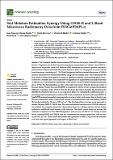Por favor, use este identificador para citar o enlazar a este item:
http://hdl.handle.net/10261/233544COMPARTIR / EXPORTAR:
 SHARE SHARE
 CORE
BASE CORE
BASE
|
|
| Visualizar otros formatos: MARC | Dublin Core | RDF | ORE | MODS | METS | DIDL | DATACITE | |

| Título: | Soil Moisture Estimation Synergy Using GNSS-R and L-Band Microwave Radiometry Data from FSSCat/FMPL-2 |
Autor: | Muñoz-Martín, Joan Francesc; Llaveria, David; Herbert, Christoph; Pablos, Miriam CSIC ORCID ; Park, Hyuk; Camps, Adriano CSIC ORCID | Palabras clave: | GNSS-R L-band Microwave radiometry CubeSats Soil moisture |
Fecha de publicación: | mar-2021 | Editor: | Multidisciplinary Digital Publishing Institute | Citación: | Remote Sensing 13(5): 994 (2021) | Resumen: | The Federated Satellite System mission (FSSCat) was the winner of the 2017 Copernicus Masters Competition and the first Copernicus third-party mission based on CubeSats. One of FSSCat’s objectives is to provide coarse Soil Moisture (SM) estimations by means of passive microwave measurements collected by Flexible Microwave Payload-2 (FMPL-2). This payload is a novel CubeSat based instrument combining an L1/E1 Global Navigation Satellite Systems-Reflectometer (GNSS-R) and an L-band Microwave Radiometer (MWR) using software-defined radio. This work presents the first results over land of the first two months of operations after the commissioning phase, from 1 October to 4 December 2020. Four neural network algorithms are implemented and analyzed in terms of different sets of input features to yield maps of SM content over the Northern Hemisphere (latitudes above 45 ºN). The first algorithm uses the surface skin temperature from the European Centre of Medium-Range Weather Forecast (ECMWF) in conjunction with the 16 day averaged Normalized Difference Vegetation Index (NDVI) from the Moderate Resolution Imaging Spectroradiometer (MODIS) to estimate SM and to use it as a comparison dataset for evaluating the additional models. A second approach is implemented to retrieve SM, which complements the first model using FMPL-2 L-band MWR antenna temperature measurements, showing a better performance than in the first case. The error standard deviation of this model referred to the Soil Moisture and Ocean Salinity (SMOS) SM product gridded at 36 km is 0.074 m3/m3. The third algorithm proposes a new approach to retrieve SM using FMPL-2 GNSS-R data. The mean and standard deviation of the GNSS-R reflectivity are obtained by averaging consecutive observations based on a sliding window and are further included as additional input features to the network. The model output shows an accurate SM estimation compared to a 9 km SMOS SM product, with an error of 0.087 m3/m3. Finally, a fourth model combines MWR and GNSS-R data and outperforms the previous approaches, with an error of just 0.063 m3/m3. These results demonstrate the capabilities of FMPL-2 to provide SM estimates over land with a good agreement with respect to SMOS SM | Descripción: | Special issue Applications of GNSS Reflectometry for Earth Observation II.-- 22 pages, 13 figures, 2 tables, supplementary material https://doi.org/10.3390/rs13050994.-- Data used in this study will be publicly and freely available for everyone at the Copernicus system as part of the FSSCat mission | Versión del editor: | https://doi.org/10.3390/rs13050994 | URI: | http://hdl.handle.net/10261/233544 | DOI: | 10.3390/rs13050994 | E-ISSN: | 2072-4292 |
| Aparece en las colecciones: | (ICM) Artículos |
Ficheros en este ítem:
| Fichero | Descripción | Tamaño | Formato | |
|---|---|---|---|---|
| Munoz_et_al_2021.pdf | 1,8 MB | Adobe PDF |  Visualizar/Abrir | |
| Munoz_et_al_2021_suppl.gif | 9,53 MB | GIF |  Visualizar/Abrir |
CORE Recommender
SCOPUSTM
Citations
20
checked on 16-abr-2024
WEB OF SCIENCETM
Citations
17
checked on 27-feb-2024
Page view(s)
96
checked on 19-abr-2024
Download(s)
136
checked on 19-abr-2024
Google ScholarTM
Check
Altmetric
Altmetric
Este item está licenciado bajo una Licencia Creative Commons

